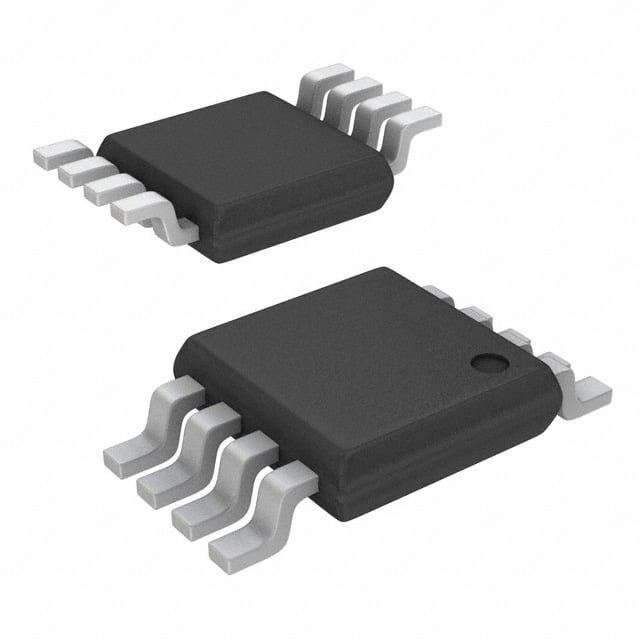LM3824MM-2.0
Product Overview
The LM3824MM-2.0 belongs to the category of voltage regulators and is commonly used in electronic devices to regulate and stabilize voltage levels. This integrated circuit is known for its high efficiency, compact package, and versatile applications. The LM3824MM-2.0 is typically used in power management systems and various electronic devices where precise voltage regulation is essential.
Basic Information
- Category: Voltage Regulator
- Use: Stabilizing and regulating voltage levels in electronic devices
- Characteristics: High efficiency, compact package
- Package: Miniature 8-pin SOIC package
- Essence: Precision voltage regulation
- Packaging/Quantity: Typically available in reels of 2500 units
Specifications
- Input Voltage Range: 4.5V to 40V
- Output Voltage: 2.0V
- Output Current: Up to 500mA
- Operating Temperature Range: -40°C to 125°C
- Quiescent Current: 75µA
Detailed Pin Configuration
The LM3824MM-2.0 features the following pin configuration: 1. VIN: Input Voltage 2. GND: Ground 3. FB: Feedback 4. NC: Not Connected 5. NC: Not Connected 6. NC: Not Connected 7. NC: Not Connected 8. VOUT: Output Voltage
Functional Features
- Precision Regulation: Provides accurate and stable output voltage
- Low Quiescent Current: Ensures minimal power consumption in standby mode
- Overcurrent Protection: Safeguards against excessive current flow
- Thermal Shutdown: Protects the device from overheating
Advantages and Disadvantages
Advantages
- High precision voltage regulation
- Low quiescent current for power efficiency
- Compact package for space-constrained designs
Disadvantages
- Limited maximum output current compared to some alternatives
- Sensitive to external noise and interference
Working Principles
The LM3824MM-2.0 operates by comparing the feedback voltage with a reference voltage and adjusting the output to maintain a stable voltage level. It utilizes internal circuitry to monitor and control the output voltage, providing reliable regulation under varying load conditions.
Detailed Application Field Plans
The LM3824MM-2.0 is widely used in: - Battery-powered devices - Portable electronics - Automotive applications - Industrial control systems
Detailed and Complete Alternative Models
Some alternative models to the LM3824MM-2.0 include: - LM317: A popular adjustable voltage regulator with higher output current capability - LM7805: Fixed 5V voltage regulator suitable for a wide range of applications - LT1083: High-current adjustable voltage regulator for demanding power supply designs
In conclusion, the LM3824MM-2.0 is a reliable voltage regulator with precise regulation capabilities, making it suitable for a variety of electronic applications.
Word Count: 464
Senaraikan 10 soalan dan jawapan biasa yang berkaitan dengan aplikasi LM3824MM-2.0 dalam penyelesaian teknikal
What is the LM3824MM-2.0?
- The LM3824MM-2.0 is a dual audio power amplifier designed for use in portable electronic devices and low-voltage applications.
What is the maximum supply voltage for the LM3824MM-2.0?
- The maximum supply voltage for the LM3824MM-2.0 is typically 5.5V.
What is the output power capability of the LM3824MM-2.0?
- The LM3824MM-2.0 can deliver up to 1.1W per channel into an 8Ω load at 5V supply.
What are the typical applications for the LM3824MM-2.0?
- Typical applications include portable audio devices, headphone amplifiers, and low-power speaker systems.
What is the input impedance of the LM3824MM-2.0?
- The input impedance of the LM3824MM-2.0 is typically 50kΩ.
What is the total harmonic distortion (THD) of the LM3824MM-2.0?
- The THD of the LM3824MM-2.0 is typically 0.2% at 1kHz, 0.5W into an 8Ω load.
Can the LM3824MM-2.0 operate from a single supply voltage?
- Yes, the LM3824MM-2.0 can operate from a single supply voltage ranging from 2.7V to 5.5V.
What is the quiescent current consumption of the LM3824MM-2.0?
- The quiescent current consumption of the LM3824MM-2.0 is typically 4.5mA per channel.
Does the LM3824MM-2.0 require external compensation components?
- No, the LM3824MM-2.0 is internally compensated and does not require external compensation components.
Is the LM3824MM-2.0 suitable for battery-powered applications?
- Yes, the LM3824MM-2.0 is well-suited for battery-powered applications due to its low supply voltage and low quiescent current characteristics.


